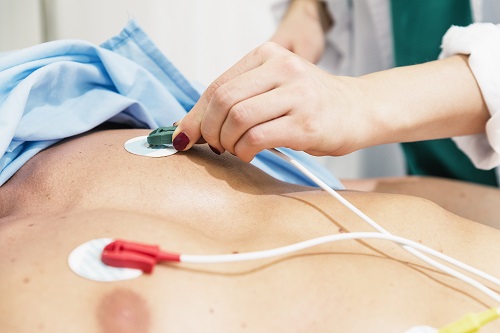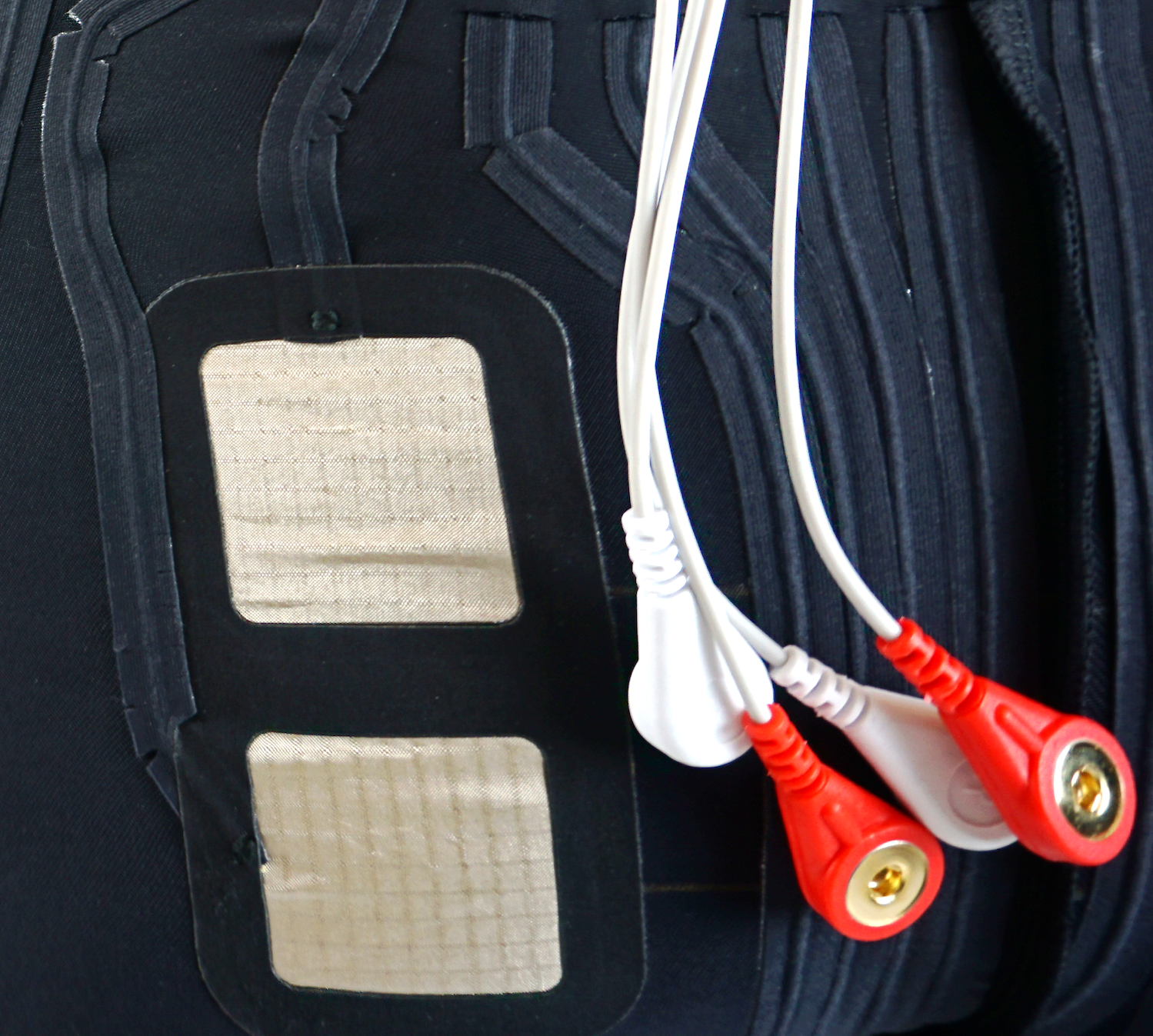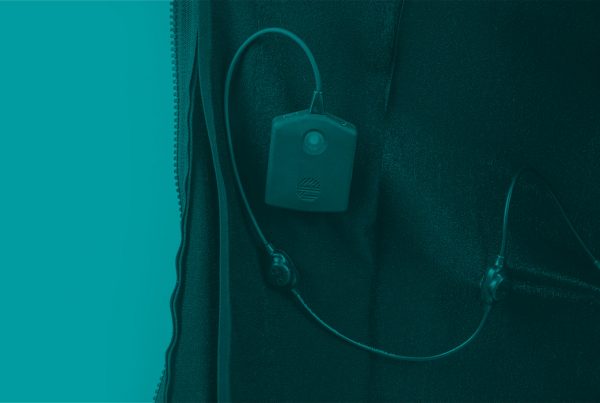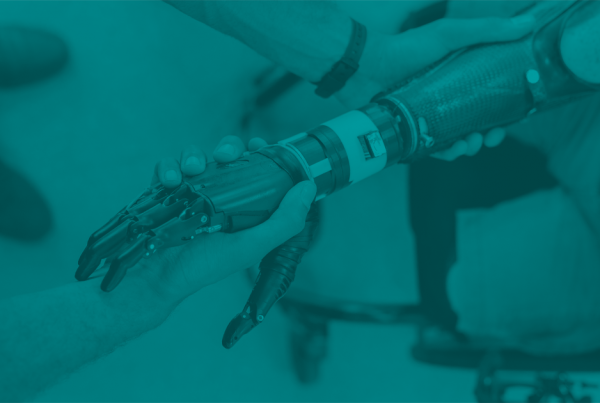Wearables are smart electronic devices that can be worn as accessories or fully embedded garments that can send and receive data from the internet; often, they measure electrical signals from the human body through a sensor; but what role do electrodes play in this, what are they exactly, and what are they used for? After reading this blog post, you will have a basic understanding of electrodes in wearables, their applications, and their challenges.
Electric signals in the human body
Our cells communicate with each other by transporting ions through the cell membrane. It is required to send signals throughout the body and to the brain, making it possible for us to move, think and feel. This movement of ions can be measured electrically. These signals are very small – a thousandth of a volt.

An electrode is a conductor (so something that can transfer electricity) that makes electrical contact with a non-metallic part of the circuit. Electrodes either sense tiny electrical signals from, for example, the heart, or they stimulate tissues in the human body, like suppressing pain in pregnant women.
Electrodes come in many different shapes, materials, and sizes; the most well-known version is the disposable adhesive hydrogel electrode, to which a cable can be connected through a snap button.
Electrodes as sensors
Now let’s dive deeper into the world of electrodes and get ready, because the choice is immense.

ECG electrodes
The first example of an electrode as a sensor can be seen in electrocardiography, also known as ECG, where the electrical activity of the heart is charted over time. A medical ECG uses ten electrodes and gives a doctor a three-dimensional view of the electrical activity in the heart. This data can then be used for diagnosing misfunction of each part of the heart. Often cheap disposable adhesive hydrogel electrodes are used in this application.
ECG wearables are more focused on tracking sports activities, sleep, and improving overall health. From the ECG, other signals are derived like the heart rate (HR), which is the interval between two peaks in the ECG and is an indicator of body activity. Another derivative is heart rate variation (HRV), which is a good indicator of stress.
Another example is the EMG or electromyography, which is often used to analyse muscle activation. In medical applications, it is used to diagnose neural and muscular problems, while in research and sports, the application is to study muscular activation. Often the same cheap disposable adhesive hydrogel electrodes as in ECG are used.
EEG electrodes
The third example is electroencephalography or EEG, which measures the electrical activity of the brain. Typical medical applications are the diagnosing of epilepsy or sleep disorders.
Researchers used EEG to study brain function and for example to control a computer by thoughts in a brain-computer interface (BCI). During EEG research, typically tens of small metal disc-electrodes are placed in a cap over the scalp.

The challenge is in the high skin resistance and the small signal, a millionth of a volt, that causes the EEG signal to be easily disturbed. Often to reduce skin resistance the skin is scratched, and conductive gel is applied which is a time-consuming and dirty process.
The EEG is also highly sensitive to environmental noise and movement artefacts. Therefore, an EEG requires a lot of signal filtering and artefact reduction algorithms.
Often wearable EEG devices are non-medical products that using an app help improve sleep, focus or productivity. They are also used to help exercise meditation and to monitor moods and emotions. For these applications dry electrodes are used, without conductive gel, to make them easier to place and remove.
Dry electrodes are often spiky and pushed hard into the skin to reduce contact resistance and are therefore not comfortable to wear for a longer period.
Electrodes for stimulation
Besides sensing electrical signals, electrodes can also give electrical signals to the human body. For example, electrical stimulation of muscles can move. But it can also reduce pain and can even stimulate the regrowth of neural fibres after a neural injury.

A well-known example is Electro Muscle Stimulation (EMS), in which muscles are excited (tensed) by a large stimulation current. A cool product example where EMS is used is the full body training suits to intensify your workout routine. The additional electrical current applied to the muscles makes them work harder, resulting in an intensified workout.
Another example of electrodes as actuators is Transcutaneous Electrical Neurostimulation or TENS, which sends a small electrical current through the skin, usually smaller than EMS. The current through the nerve fibres blocks or at least reduces the pain signals travelling to the brain. TENS devices are often used by pregnant women on the lower back.
The electrodes are often inexpensive large reusable hydrogel electrode pads. Alternatively, there are wet textile electrodes made from conductive textiles that are non-adhesive and reusable.
The challenge with stimulation electrodes is that the large current induces pain as it activates the underlying pain-sensing neural fibres. By using a large surface area and wet electrodes, we can reduce hot spots in current density and avoid activating the pain nerves.
Wearables and electrodes
Now that we know some typical electrodes and their applications, it is interesting to look at future possibilities. Most of these electrodes are visually present, adhesive and used only once.
By integrating electrodes into textile products, just as we do every day in our Wearables Lab, we can make wearables with electrodes reusable, sustainable, easier to use, and visually attractive. For example, to measure

the heart signal, we could integrate textile electrodes knitted in a t-shirt. Now data collection becomes almost invisible, as it looks and feels like a normal t-shirt.
However, the user can go about their daily routine, without experiencing too many drawbacks from the constant monitoring device. Afterwards, the shirt can be laundered and reused.
In a nutshell
Electrodes are electricity transmitters that can detect electrical impulses coming from the body or stimulate the body to improve our wellbeing.
There are numerous types of electrodes and for various applications. They can be employed as sensors, such as ECG, which measures heart activity; EMG, which monitors muscle activation; and EEG, which measures brain electrical activity. Electrodes can also be used for stimulation, for example, to activate the muscles for an improved exercise routine (EMS), or to suppress pain (TENS).
Electrodes in wearables can be small and easily integrated into textiles to improve the comfort of the garment or accessory, and reliability of the tracked data.
The new developments in textile electrodes open the door to many novel wearables that can measure and improve body performance. It also allows for home therapy, medical testing and remote monitoring of patients, addressing the need for more accessible and more affordable medical care.
Watch our free-on-demand webinar Electrodes for Wearables to get a sneak preview of how electrodes are just only the beginning of great wearable projects.
Are you ready to unlock the power of electrodes for your wearables? Get in touch with us to create a life-improving wearable with integrated electrodes.
By: Jasper Sikken
7 February 2023






